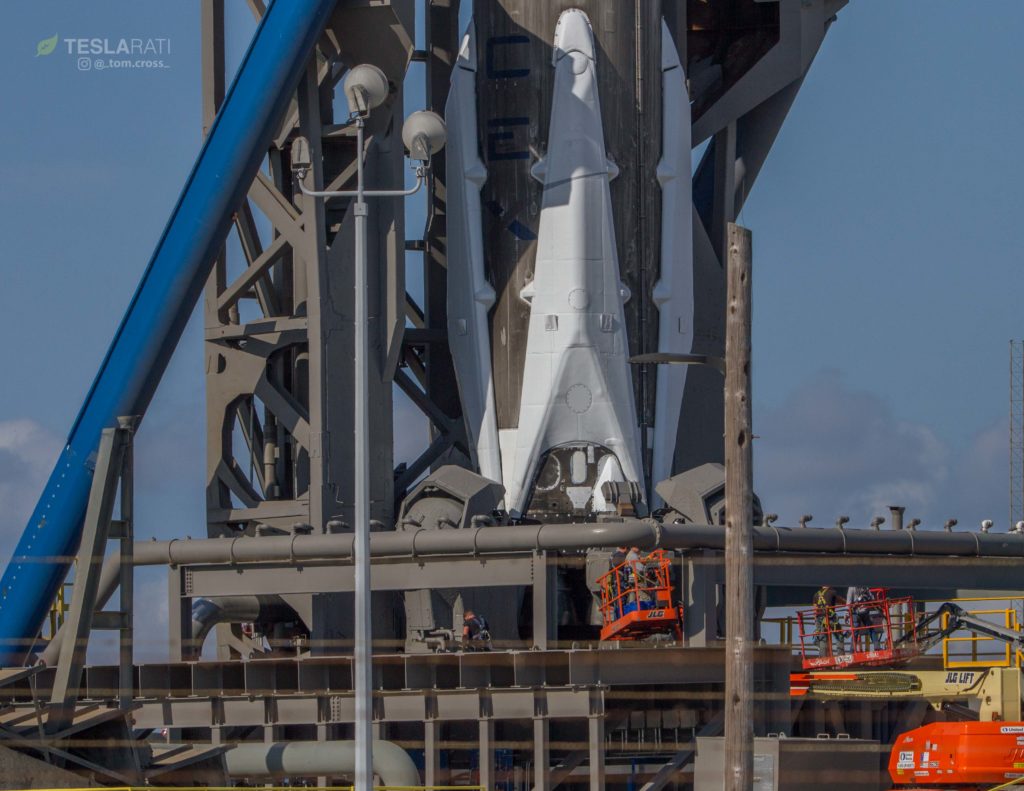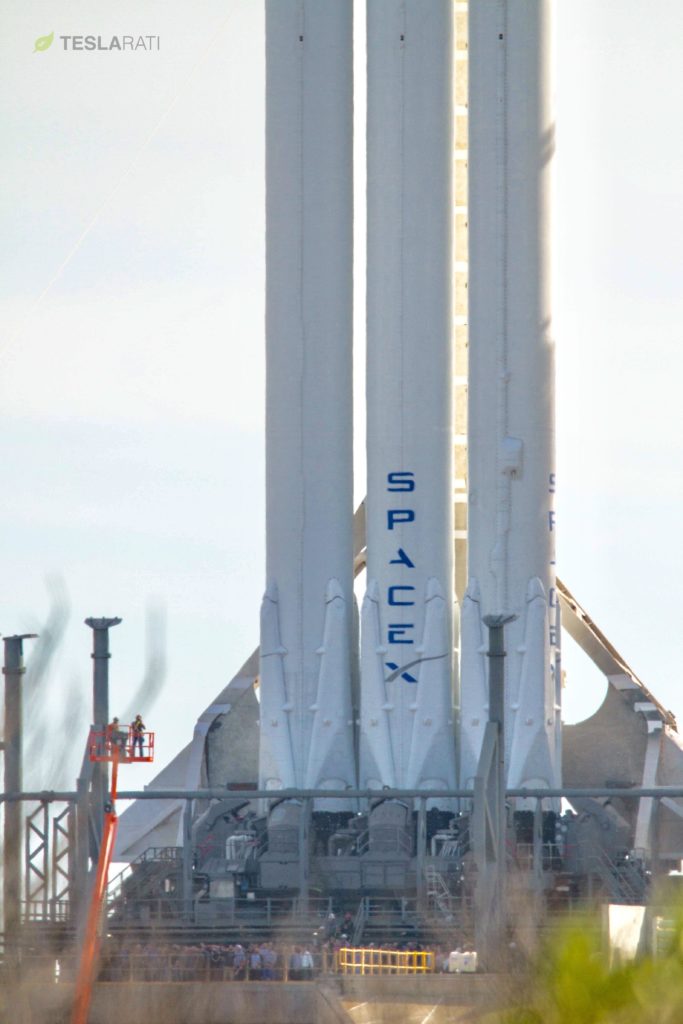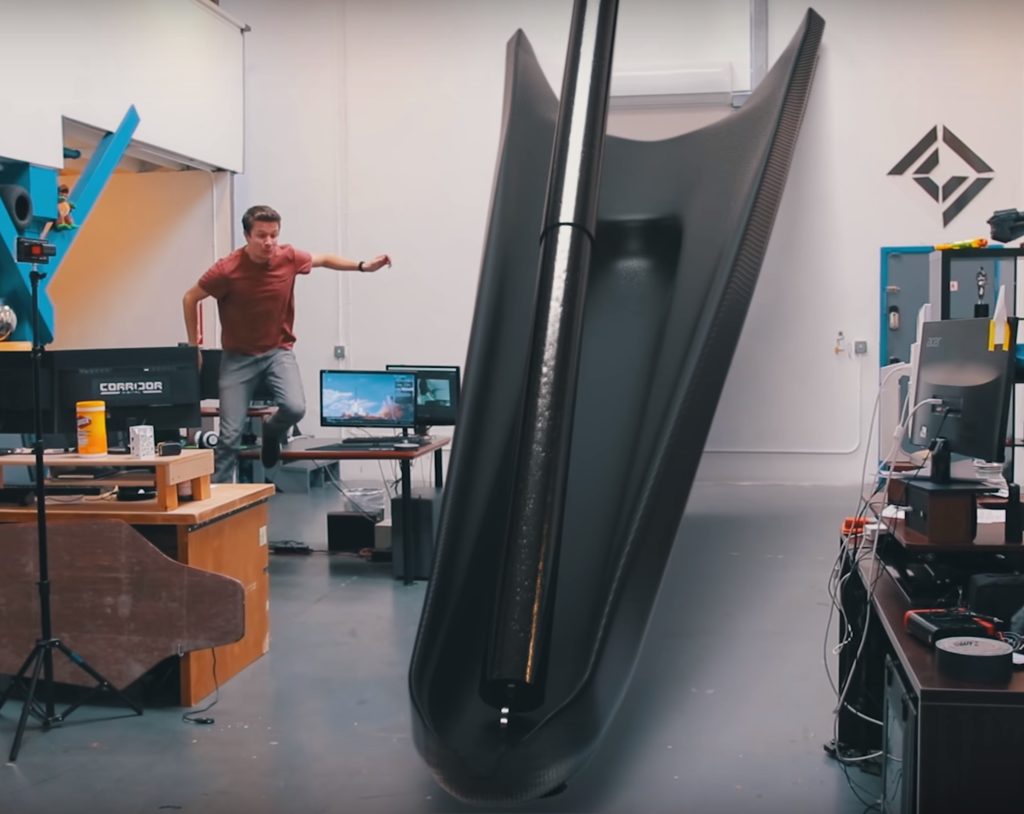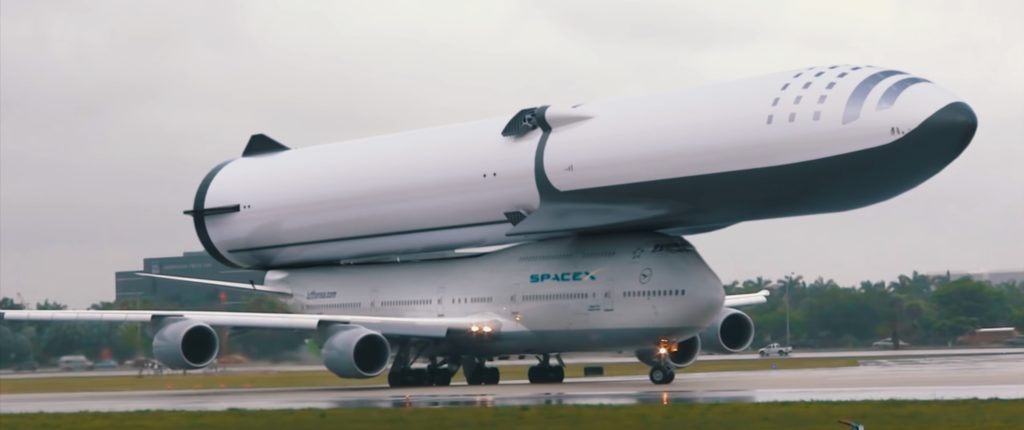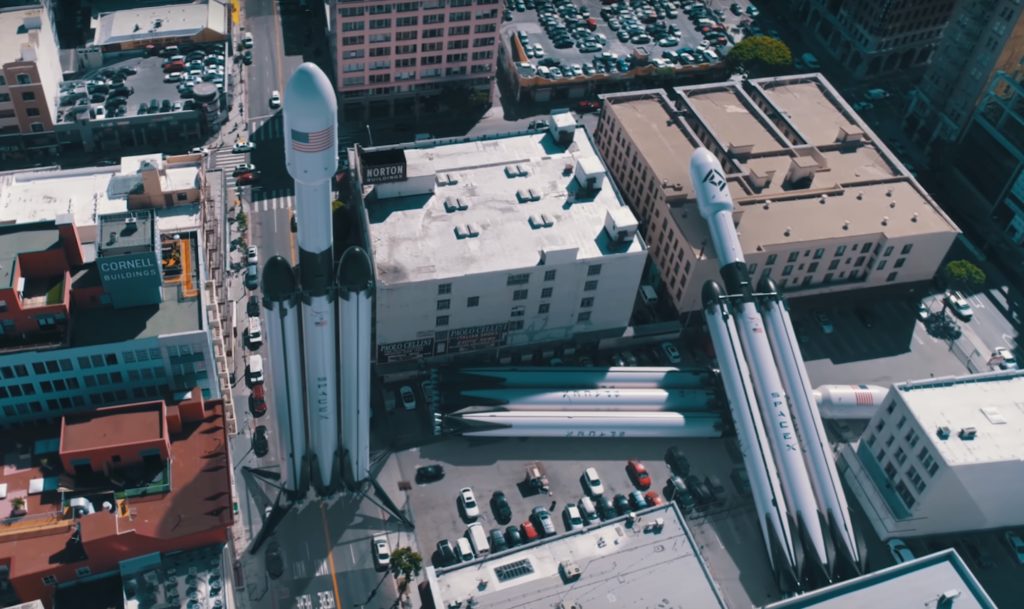
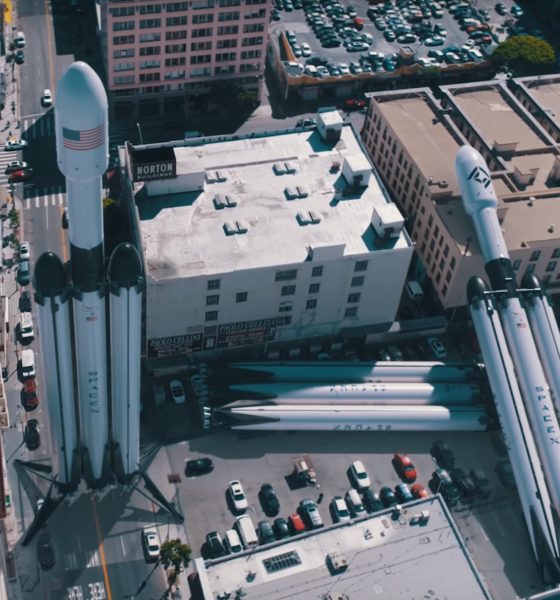
SpaceX
This is how big SpaceX’s Falcon Heavy and BFR rocket is in real life
An artist duo has published an impressive, unofficial look at the true size of SpaceX’s reusable rockets, using a brilliant combination of 3D modeling and animation to really compare Falcon 9, Falcon Heavy, and BFR with recognizable landmarks and cityscapes, lending an incredible sense of scale to the extraordinary feats of engineering that SpaceX routinely launches, lands, and relaunches every month.
In the video, posted on the Corridor YouTube channel on June 19, VFX artist Wren Weichman — known on social media as “sirwrender” — acts as the host of a brief clip where he tours viewers around an office and several cityscapes populated with scale-model 3D renders of all of SpaceX’s various rockets, both those currently operational and those under development. His point is undeniably true: human brains simply are not accustomed to or easily able to build accurate mental pictures of vast real-world objects. The reality almost invariably comes as a visceral shock to onlookers, even those that know better than to trust their perceptual instincts. Be it grand natural wonders or human constructs, humans are quite simply bad at estimating scale until they do so in person.
- SpaceX technicians work at the base of Falcon 9 B1039 ahead of launch, CRS-14. (Tom Cross)
- The scale of Falcon Heavy. (Photo: Tom Cross)
- The hypersonic X-15 and Falcon 9 S1, with a common 737-800 airliner on the right. All vehicles are roughly to scale. (Wikipedia, SpaceX)
With the case of rockets and their launches, this is doubly true and further exaggerated by the fact that launch webcasts, videos, and photos often feature unfamiliar backgrounds of industrial equipment or a perfectly featureless skies, all while almost invariably excluding (for good reasons…) familiarly scaled features like people, cars, animals, or everyday buildings. In many cases, preparations for rocket launches are often the absolute best times available for photos that truly give a sense of scale, as it’s actually reasonably safe to be and work in close proximity to an unfueled rocket.
With the help of models of Falcon 9, Heavy, and BFR created by 3D design Reese Wilson (@AstroReeseW), Wren (@sirwrender) takes those scale shortcomings to task and does his best to create examples with the very cues that average fans and viewers rarely get to see alongside real-life rockets.
- Wren’s example of a rough, uneducated estimate of Falcon 9 legs based on easily available images and livestreams. (sirwrender/astroreesew)
- The full-sized Falcon 9 landing leg is just a smidge larger in reality. (sirwrender/astroreesew)
- A handful of rather absurd cases also serve to illustrate just how huge SpaceX’s rockets are. (sirwrender/astroreesew)
- Just your run-of-the-mill pile of Falcon Heavies in suburban New York City. (sirwrender/astroreesew)
The video really needs to be watched to be fully appreciated – my favorite segment is near the start, where Wren notes that viewers likely expect some of the seemingly insignificant components, projecting a layperson size-estimate of a Falcon 9 landing leg inside his workplace before expanding it all the way to full-scale, at which point the leg literally does not fit inside the office. Visualizations of BFR further show that the crewed Mars rocket will effortlessly dwarf the already massive Falcon 9 and Heavy.
Regardless of whether you were or were not intimately familiar with the actual scale of SpaceX’s many rockets, Wren and Reese make for a seriously entertaining (and educational) combination. Here’s to hoping the duo ventures into more spaceflight and SpaceX videos in the future! Enjoy the video below.

Elon Musk
SpaceX maintains unbelievable Starship target despite Booster 18 incident
It appears that it will take more than an anomaly to stop SpaceX’s march towards Starship V3’s refinement.

SpaceX recently shared an incredibly ambitious and bold update about Starship V3’s 12th test flight.
Despite the anomaly that damaged Booster 18, SpaceX maintained that it was still following its plans for the upgraded spacecraft and booster for the coming months. Needless to say, it appears that it will take more than an anomaly to stop SpaceX’s march towards Starship V3’s refinement.
Starship V3 is still on a rapid development path
SpaceX’s update was posted through the private space company’s official account on social media platform X. As per the company, “the Starbase team plans to have the next Super Heavy booster stacked in December, which puts it on pace with the test schedule planned for the first Starship V3 vehicle and associated ground systems.”
SpaceX then announced that Starship V3’s maiden flight is still expected to happen early next year. “Starship’s twelfth flight test remains targeted for the first quarter of 2026,” the company wrote in its post on X.
Elon Musk mentioned a similar timeline on X earlier this year. In the lead up to Starshp Flight 11, which proved flawless, Musk stated that “Starship V3 is a massive upgrade from the current V2 and should be through production and testing by end of year, with heavy flight activity next year.” Musk has also mentioned that Starship V3 should be good enough to use for initial Mars missions.
Booster 18 failure not slowing Starship V3’s schedule
SpaceX’s bold update came after Booster 18 experienced a major anomaly during gas system pressure testing at SpaceX’s Massey facility in Starbase, Texas. SpaceX confirmed in a post on X that no propellant was loaded, no engines were installed, and personnel were positioned at a safe distance when the booster’s lower section crumpled, resulting in no injuries.
Still, livestream footage showed significant damage around the liquid oxygen tank area of Booster 18, leading observers to speculate that the booster was a total loss. Booster 18 was among the earliest vehicles in the Starship V3 series, making the failure notable. Despite the setback, Starship V3’s development plans appear unchanged, with SpaceX pushing ahead of its Q1 2026 test flight target.
Elon Musk
SpaceX issues statement on Starship V3 Booster 18 anomaly
The incident unfolded during gas-system pressure testing at the company’s Massey facility in Starbase, Texas.

SpaceX has issued an initial statement about Starship Booster 18’s anomaly early Friday. The incident unfolded during gas-system pressure testing at the company’s Massey facility in Starbase, Texas.
SpaceX’s initial comment
As per SpaceX in a post on its official account on social media platform X, Booster 18 was undergoing gas system pressure tests when the anomaly happened. Despite the nature of the incident, the company emphasized that no propellant was loaded, no engines were installed, and personnel were kept at a safe distance from the booster, resulting in zero injuries.
“Booster 18 suffered an anomaly during gas system pressure testing that we were conducting in advance of structural proof testing. No propellant was on the vehicle, and engines were not yet installed. The teams need time to investigate before we are confident of the cause. No one was injured as we maintain a safe distance for personnel during this type of testing. The site remains clear and we are working plans to safely reenter the site,” SpaceX wrote in its post on X.
Incident and aftermath
Livestream footage from LabPadre showed Booster 18’s lower half crumpling around the liquid oxygen tank area at approximately 4:04 a.m. CT. Subsequent images posted by on-site observers revealed extensive deformation across the booster’s lower structure. Needless to say, spaceflight observers have noted that Booster 18 would likely be a complete loss due to its anomaly.
Booster 18 had rolled out only a day earlier and was one of the first vehicles in the Starship V3 program. The V3 series incorporates structural reinforcements and reliability upgrades intended to prepare Starship for rapid-reuse testing and eventual tower-catch operations. Elon Musk has been optimistic about Starship V3, previously noting on X that the spacecraft might be able to complete initial missions to Mars.
Elon Musk
SpaceX Starship Version 3 booster crumples in early testing
Photos of the incident’s aftermath suggest that Booster 18 will likely be retired.

SpaceX’s new Starship first-stage booster, Booster 18, suffered major damage early Friday during its first round of testing in Starbase, Texas, just one day after rolling out of the factory.
Based on videos of the incident, the lower section of the rocket booster appeared to crumple during a pressurization test. Photos of the incident’s aftermath suggest that Booster 18 will likely be retired.
Booster test failure
SpaceX began structural and propellant-system verification tests on Booster 18 Thursday night at the Massey’s Test Site, only a few miles from Starbase’s production facilities, as noted in an Ars Technica report. At 4:04 a.m. CT on Friday, a livestream from LabPadre Space captured the booster’s lower half experiencing a sudden destructive event around its liquid oxygen tank section. Post-incident images, shared on X by @StarshipGazer, showed notable deformation in the booster’s lower structure.
Neither SpaceX nor Elon Musk had commented as of Friday morning, but the vehicle’s condition suggests it is likely a complete loss. This is quite unfortunate, as Booster 18 is already part of the Starship V3 program, which includes design fixes and upgrades intended to improve reliability. While SpaceX maintains a rather rapid Starship production line in Starbase, Booster 18 was generally expected to validate the improvements implemented in the V3 program.
Tight deadlines
SpaceX needs Starship boosters and upper stages to begin demonstrating rapid reuse, tower catches, and early operational Starlink missions over the next two years. More critically, NASA’s Artemis program depends on an on-orbit refueling test in the second half of 2026, a requirement for the vehicle’s expected crewed lunar landing around 2028.
While SpaceX is known for diagnosing failures quickly and returning to testing at unmatched speed, losing the newest-generation booster at the very start of its campaign highlights the immense challenge involved in scaling Starship into a reliable, high-cadence launch system. SpaceX, however, is known for getting things done quickly, so it would not be a surprise if the company manages to figure out what happened to Booster 18 in the near future.
